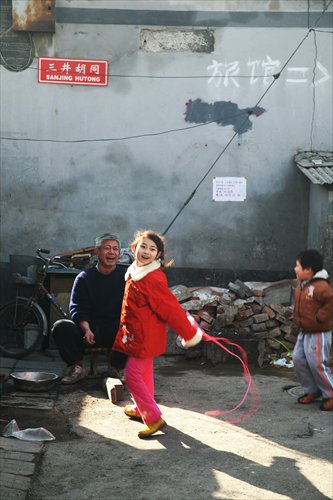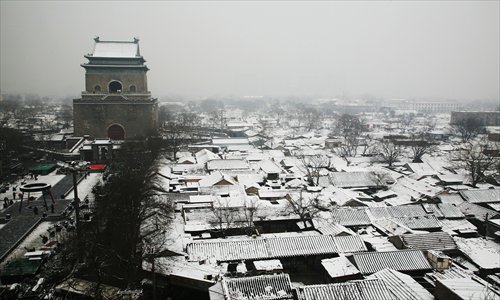Click down memory lane

Joe Olsson (left) and Hou Lei tell the stories of Beijing's hutong and its residents through their photographs. Photo: Li Hao/GT
Joe Olsson and Hou Lei always attract plenty of stares from elderly locals when they wander around Beijing's hutong. The pair of photographers is on a mission to capture the charm of Beijing's historic alleyways one photo at a time.
"One advantage is that people are interested in us as a laowai and a local Beijinger. They even invite us into their homes. However, they might be suspicious if we were two foreigners or two Chinese from other provinces," says Olsson, a 30-year-old Swede.
"We first make friends with [residents]. I talk about the hutong I once lived in. Most people are happy to talk a little bit about the history of a hutong, but some are unwilling to be photographed," says Hou, 29, who grew up in a hutong near Dashilan, a historic commercial area near Qianmen, Dongcheng district.
Originally from Linköping in southern Sweden, Olsson first came to China in 2004 while backpacking. He had previously been interested in Chinese culture, majoring in Chinese modern history at university. In 2007, the writer and photographer relocated to Beijing, where he has lived ever since.
Olsson teamed up with Hou to take photos of hutong in early 2012, but the duo isn't alone in their quest to portray an ancient part of Beijing pushed to the brink of oblivion by developers in the modern age.
A girl jumps rope in Sanjing Hutong, Xicheng district. Photo: Courtesy of Jiang Chenming
Olsson says his main goal as a photographer is to focus on the "humanity of the hutong," which is a task made easier by residents' hospitality and openness. "Gates are usually not locked, and you just wander into courtyards and chat with people," he says. Some people who appear in Olsson and Hou's photos are friends or acquaintances contacted in advance, while the rest are friendly strangers.
Meeting near Olsson's home in Langjia Hutong, Dongcheng district, Hou took pride in showing Metropolitan the duo's portfolio. Their photos include shots of siheyuan (traditional courtyard homes), the Drum and Bell towers, trash cans and time-honored stores. More impressive, however, are photos of people that include fruit and vegetable vendors, children playing kongzhu (diabolo) or riding bikes, masons repairing roofs and bangye (shirtless grandfathers) playing mahjong in summer.
"Olsson especially likes taking photos of garbage," jokes Hou. "It actually shows that nowadays hutong waste management is a mess."
Like their counterparts who live in high-rise apartment buildings, space is at a premium in the hutong. One of Olsson's photos of clothes hung out to dry on a bicycle demonstrates this, but he is quick to point out there are many differences between hutong residents and apartment dwellers.
"Children who live in the hutong fight with each other and repair their own bikes, while children living in apartment buildings watch TV and do their homework. Hutong kids are much happier, I think," says Olsson.
The Swede gestures at another of his photos depicting a chubby toddler. "He might be a member of the last generation who grows up in the hutong, or maybe the hutong will be gone before he even grows up," he sighs.
Although Stockholm with its immaculate streets and orderly traffic might seem a world away from Beijing, Olsson says the Swedish capital has endured similar struggles with modernization. Some of its old residential areas were razed during the 1950s and 1960s so that new buildings could be constructed. "Years later, [locals] realized that they should have saved some of the culture, and they were regretful," says Olsson. "But I think it will be more difficult for Beijing [to save the hutong] because the city has developed so fast and decisions are made quicker."
For Hou, holding on to hutong heritage has become a personal plight. "Since I grew up in the hutong, I feel connected to every single brick and tile. My photos are lively and vivid, whereas Olsson is more professional in terms of color and composition," Hou says. "In Beijing, we have a saying that goes: 'The east is rich, the west is noble, the south is poor and the north is dilapidated,'" he adds, referring to the capital's hutong neighborhoods.
Hou and Olsson have ventured to nearly all of Beijing's hutong, but this task has been more challenging in the southern neighborhoods populated mostly by migrant workers who live more in shanty towns than preserved hutong.

Children's quilted jackets air in Jiudaowanxixiang Hutong, Dongcheng district. Photo: Courtesy of Jiang Chenming

The Bell Tower looms over snow-capped hutong homes. Photo: Courtesy of Jiang Chenming
Storytelling through photographyOne of the duo's favorite photos is of an elderly lady sitting at her front door in the hutong she has lived in her entire life. She told Olsson and Hou that her family bought the siheyuan in the early 1940s.
During the Cultural Revolution (1966-76), dozens of Red Guards moved into her home. Much of her home's furniture was destroyed and her father was beaten, leaving him permanently deaf in his left ear.
"Violence happened in the yard and the family still lives in the house, so I think their story is very interesting," says Olsson. "Although some of these are really sensitive topics, you can't hear these stories elsewhere."
Jiang Chenming, another hutong photographer, agrees that it is the residents more than the environment that make hutong such a captivating subject. When Jiang moved to Beijing from Shandong Province to work as a media photographer, he was puzzled at how so many shabby hutong dwellings could be found within the Second Ring Road.
Jiang used his spare time to cycle along hutong on photography expeditions. "My first and superficial impression was of the architectural styles in the hutong," recalls Jiang, who has taken more than 10,000 photos of about 90 percent of Beijng's remaining 300 hutong since 2004.
In 2005, Jiang's hobby became more organized. He sprawled a giant map of the city on his living room wall, checking off each hutong he photographed to keep an accurate tally. Today, the map is all but completely shaded in.
"At first, I thought [the hutong] were beautiful, with exquisite architecture and fine details of brick carvings, gates and so on," says Jiang. "I gradually realized that the beauty of the hutong can be easily found, but it's more than a specific kind of architecture - it's a lifestyle."
Since 2008, Jiang has taken a notebook and recorder along with his camera for hutong excursions. He uses them to record stories from residents to include personal footnotes to his thousands of photographs. "Some residents are very kindhearted and tell me their stories, such as which homes used to be temples or belong to former celebrities," says Jiang.
Jiang likes both large, high-walled dwellings with spacious courtyards and small, curvy ones that he claims exude tranquility and originality. One of Jiang's favorite photos is of a line of children's quilted jackets airing in a hutong. "It's sweet. People should slow down and savor the hutong life," he sighs.

Hou Lei (front) takes a photo as Joe Olsson looks on. Photo: Li Hao/GT
Growing global awareness
Jiang, Hou and Olsson often bump into other shutterbugs as eager as they are about hutong photography.
On popular Chinese photography websites fengniao.com and xitek.com, Beijing's hutong is one of the most popular subjects for photographers professional and amateur alike.
There is even a group specializing in hutong photography that has been active for about a decade.
Some travel agencies have used their photos to promote hutong tours, which in turn encourage tourists to snap their own shots of one of the capital's most identifiable yet endangered landmarks.
In September, Olsson published a book in Swedish titled Beijing: City of Changes. He and Hou plan to publish a photography book that will feature eight of what they consider the most unique hutong, although don't expect it to include commercial tourist hot spots like Nanluoguxiang.
The duo has finished shooting six of the eight hutong, and have put their project on crowd-funding websites to build capital. Surprisingly, about 90 percent of their backers are foreigners. "Foreigners are very interested in the destiny of hutong," says Olsson.
"Most of the hutong have gone and in the next seven or eight years, there will be even fewer left. Without its hutong, Beijing has nothing that makes it stand out from other first-tier cities in China," he said.